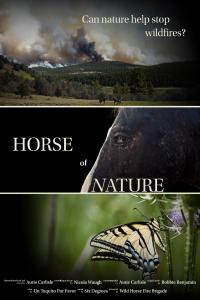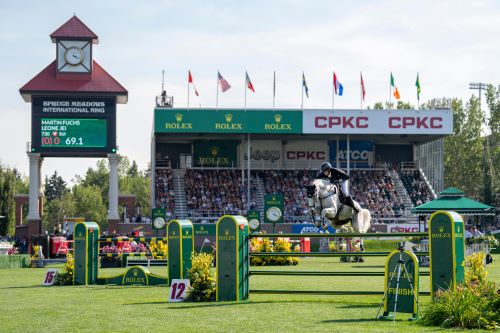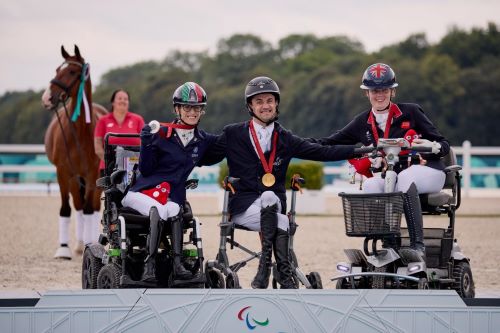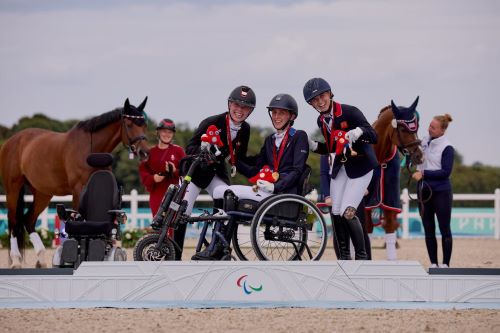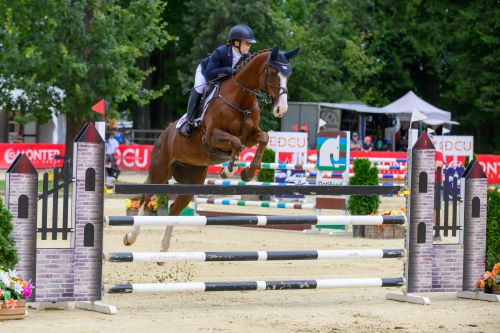L-R: Sara Morganti (ITA), Rihards Snikus (LAT), and Mari Durward-Akhurst (GBR), Individual Freestyle Grade I © FEI/Liz Gregg
Two more Individual gold medals on the final day of Freestyle crowned the United States’ best ever Para Dressage performance at a Paralympic Games as they topped the medal table at Château de Versailles.
Fiona Howard, partnering Diamond Dunes in Grade II, and Rebecca Hart with Floratina in the concluding Grade III both won their third golds at Paris 2024, after also triumphing with Roxanne Trunnell and Fan Tastico H in Friday’s Team event.
That took the USA’s tally to seven medals overall – five golds, one silver, and one bronze – to smash their previous Paralympic Games best of two golds and a bronze achieved at Atlanta 1996 and Tokyo 2020.
Saturday also brought the second Individual gold medals of these Games for Demi Haerkens (NED) and Daula in Grade IV, Michèle George (BEL) with Best of 8 in Grade V, and Rihards Snikus (LAT) on King of the Dance in Grade I.
Haerkens’ double gold, and a third silver medal in Paris for Rixt van der Horst and Royal Fonq in Grade III, saw the Netherlands finish second in the Para Dressage medal table for the third successive Paralympic Games, with six overall.
The first of the final day’s five events saw Haerkens confirm her status as a rising star of Para Equestrian as she and the chestnut mare Daula backed up their gold in the Individual test with a personal-best Freestyle score of 83.840%, featuring music from Vangelis and Era.
“It’s insane,” said the 26-year-old, who also won a silver in the Team event on her Paralympic Games debut.
“It’s very intense, long days, but it’s so good to be here and to perform in that beautiful arena with so many people, with the music you choose. It feels amazing that everything was on point. I think she enjoyed it as much as I did.”
Anna-Lena Niehues (GER) and Quimbaya 6 scored 80.900% to take silver, adding to their two bronzes in the Individual test and Team event.
Kate Shoemaker (USA) and Vianne set a challenging target of 80.170%, but had to settle for bronze, Shoemaker’s first individual Paralympic medal after a Team bronze in Tokyo, leaving defending champions Sanne Voets (NED) and Demantur fourth, with 79.880%.
George (BEL) claimed her seventh Paralympic Games title and fourth successive Freestyle gold, having won on FBW Rainman in Grade IV in 2012 and 2016 and current horse Best of 8 in Grade V at Tokyo 2020.
The combination earned a mark of 81.470%, but the 50-year-old indicated she would be looking for a new partner before Los Angeles 2028 comes around.
“This is the last time that I ride Best of 8 in a Paralympic Games, so it was emotional,” she said. “She’s 14 and will still participate in competitions because every morning she wants to train and it’s a real pleasure. I love it. But for LA she will be too old, so this means a lot. Making the incredible happen at the right time, it’s so important.”
Regine Mispelkamp (GER) and partner Highlander Delight’s posted 80.100% to take a second Individual silver at Versailles, and were also part of the German team which won Team bronze.
Sophie Wells (GBR), on LJT Egebjerggards Samoa, won her 10th Paralympic Games medal and second Individual bronze of Paris 2024 with a score of 75.445%, mirroring the podium from the Individual test.
Snikus (LAT) upgraded Individual silver from Tokyo 2020 for gold for a second time at Paris 2024 as he partnered King of the Dance to victory in the Grade I Freestyle.
The 36-year-old and his bay gelding scored 82.487% to a joyously uplifting soundtrack. “We chose happy music because we are a happy team,” said Latvia’s equestrian chef d’equipe Daria Tikhomirova, speaking on behalf of Snikus.
“I get an artistic pleasure to see him, like in the theatre when you hear a good opera or see a wonderful performance. It’s the result of a huge effort by his technical trainer and the whole team. I think it was his best Freestyle ever. It was just amazing.”
Sara Morganti (ITA), going last on Mariebelle, earned her second medal of these Paralympic Games by taking silver with 81.407%, upgrading her bronze from the Individual test and taking her overall Paralympic tally to four medals.
Mari Durward-Akhurst (GBR) responded well after a disappointing Individual test on her Paralympic Games debut to claim bronze on Athene Lindebjerg, scoring 77.747%.
The day ended with two more golden moments for the USA, Howard and Diamond Dunes delivering another remarkable personal-best performance in their debut Paralympic Games to triumph in the Grade II Individual Freestyle.
The 25-year-old and her chestnut stallion earned a score of 81.994% to back up their gold in the Individual test and contribution to the USA’s victory in the Team event.
“When I came into these Games, I just wanted to put down the best tests I could,” Howard said. “It was my first Paralympic Games and I just wanted to do my best and help out the team. But this has gone above my expectations.
“On the third day, you have to dig a little deep because my muscles are definitely tired, but I have such a great partner in Diamond Dunes and he knows his job. He gave me everything, just like the past two times. I couldn’t have asked for any more.”
Georgia Wilson (GBR) and Sakura won silver with 79.374%, adding to their bronze in the Individual test, while 69-year-old Heidemarie Dresing (GER) – the oldest Para Dressage athlete at Paris 2024 – won her first Paralympic Individual medal after three previous fourth places, taking bronze on Dooloop with 76.127%.
Hart rounded things off by clinching her second Individual gold with Floratina – and third overall including the Team event – in a tense finale to the Grade III Freestyle.
The 39-year-old and her bay mare, going last, kept their nerve to score 83.534%, the highest individual score of the four days of competition in Versailles.
“That was so wonderful,” said Hart. “I was a little concerned when we started cantering, but I was like, ‘She will come back to me; she always does.’ It’s just electric. I told her she was fine. She went, ‘Are we OK?’ and I said, ‘Yes, we’re fine,’ and she said, ‘OK, I trust you,’ and it was such a magical moment. Then we hit the markers the way we needed to.”
It was tough on Van der Horst, who had posted a superb score of 83.007% with Royal Fonq, but had to settle for a third successive silver medal at these Paralympic Games and a fifth overall, to go with three bronzes.
“It was not good for my heart,” she said of watching the final combination deny her gold. “I was so eager to get gold today and a bit disappointed it didn’t work out, but we can be really proud. Three silver medals is pretty good.”
Natasha Baker (GBR) also signed off with a second Individual bronze in Versailles on Dawn Chorus with a mark of 77.140%, and a 10th Paralympic Games medal overall.
FULL RESULTS
by Bryn Palmer
press@fei.org
www.fei.org

